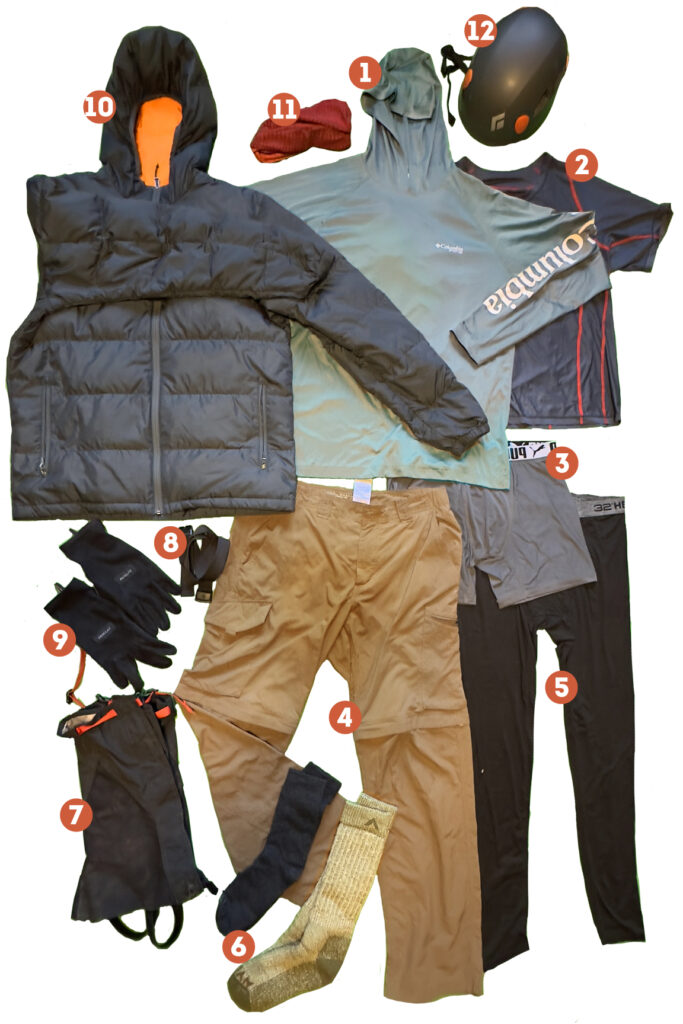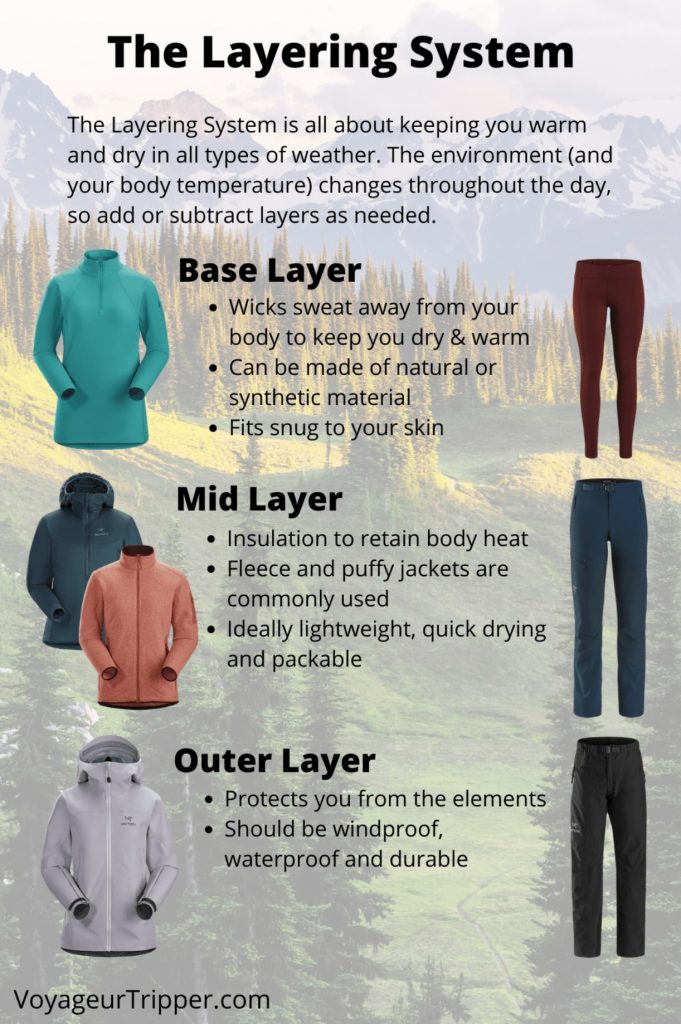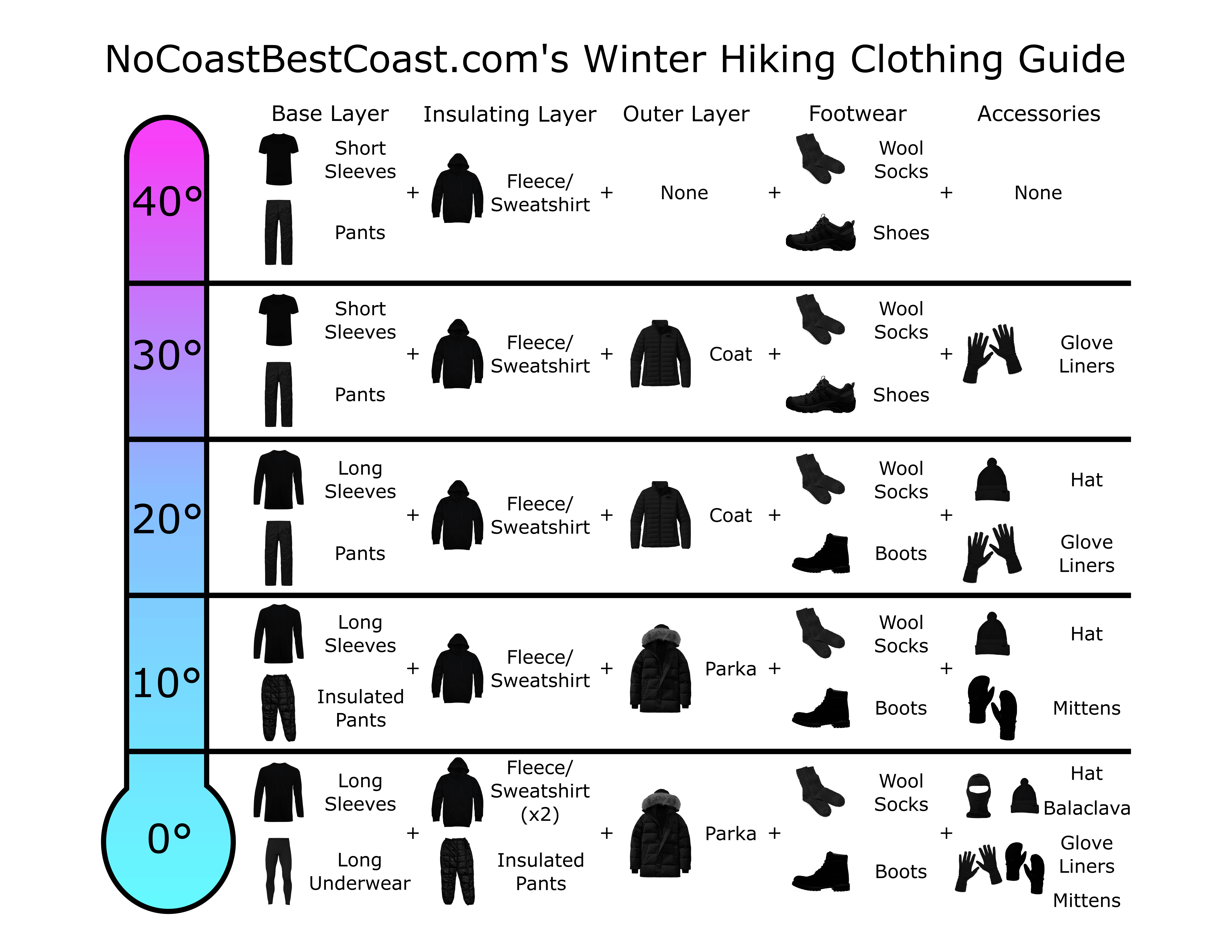The Complete Winter Hiking Clothes Guide: Stay Warm, Dry, and Safe on Every Trail
After a decade of winter hiking across mountain ranges from the Rockies to the Appalachians, I've learned that the right winter hiking clothes can make the difference between a magical adventure and a dangerous ordeal. Through countless mistakes, frozen fingers, and hard-learned lessons, I've developed a proven layering system that keeps you warm, dry, and safe in the harshest conditions.
Explore our complete outdoor gear collection for all your adventure needs.
Understanding Winter Hiking Layering Systems

The foundation of successful winter hiking clothes lies in understanding the three-layer system that has kept mountaineers and outdoor enthusiasts safe for decades. This isn't just about throwing on more clothes – it's a scientifically-backed approach to managing your body temperature and moisture while hiking in cold conditions.
During my first winter hiking attempt in Colorado's Rocky Mountain National Park, I made the classic mistake of wearing cotton and too many heavy layers. Within an hour, I was sweating profusely, and when the wind picked up at treeline, that moisture turned into a dangerous chill that forced us to turn back. That experience taught me the critical importance of proper layering.
The three-layer system consists of a moisture-wicking base layer, an insulating mid-layer, and a weather-protective outer shell. Each layer serves a specific purpose and works synergistically with the others. The base layer moves sweat away from your skin, the mid-layer traps warm air for insulation, and the outer shell blocks wind, rain, and snow while allowing moisture vapor to escape.
What makes this system so effective for winter hiking clothes is its adaptability. As your body temperature changes throughout the hike – warming up on ascents, cooling down on descents, or facing sudden weather changes – you can add or remove layers to maintain optimal comfort. This flexibility is crucial because staying dry is just as important as staying warm in winter conditions.
Understanding fabric technologies is equally important. Merino wool and synthetic materials excel at moisture management, while down and synthetic insulation provide different warmth-to-weight ratios. Modern shell fabrics offer breathability ratings that allow you to match your gear to your activity level and the conditions you'll face.
Pro Tip: Always carry extra layers in your pack, even on seemingly mild days. Mountain weather can change rapidly, and having backup insulation can be a lifesaver.
Essential Base Layers for Cold Weather
Your base layer is the most critical component of your winter hiking clothes system, yet it's often overlooked by beginners. After testing dozens of base layers across different temperature ranges and activity levels, I can confidently say that the right base layer will make or break your winter hiking experience.
The primary function of a base layer is moisture management – moving sweat away from your skin to keep you dry and comfortable. In winter conditions, staying dry isn't just about comfort; it's about survival. Wet skin loses heat 25 times faster than dry skin, turning a manageable cold day into a hypothermia risk.
Check Price: Ultra-Soft Thermal Underwear SetMerino wool remains my top choice for hiking clothes base layers due to its natural odor resistance, moisture-wicking properties, and ability to retain warmth even when wet. Unlike synthetic materials, merino wool doesn't trap odors, making it ideal for multi-day trips. I've worn the same merino base layer for five consecutive days without any unpleasant smells – try doing that with a synthetic shirt!
Choosing the Right Weight
Base layers come in different weights: lightweight (150-200 GSM), midweight (200-250 GSM), and heavyweight (250+ GSM). For winter hiking clothes, I typically recommend midweight base layers as they provide the best balance of warmth and breathability. Lightweight base layers work well for high-intensity activities or milder winter days, while heavyweight base layers are reserved for extreme cold or low-activity situations.
Fit is crucial – base layers should be snug but not restrictive. They need to maintain contact with your skin to effectively wick moisture, but they shouldn't bind or chafe during movement. I prefer base layers with flat seams and extended torso lengths to prevent gaps when reaching or bending.
User Review Summary - Amazon Customer Sarah M.
"I've been using these thermal base layers for winter hiking in Vermont, and they're incredible. The moisture-wicking works so well that I stay dry even on steep climbs. The fit is perfect – snug without being restrictive. Worth every penny for serious winter hikers."
Mid-Layers and Insulation

Mid-layers provide the insulation in your winter hiking clothes system, and choosing the right type can dramatically impact your comfort and safety. After years of testing different insulation types across various conditions, I've developed specific recommendations based on activity level, weather conditions, and personal heat production.
Fleece remains one of my favorite mid-layer options for best hiking clothes in winter conditions. It's breathable, quick-drying, and continues to insulate even when damp. Polartec fleeces offer excellent warmth-to-weight ratios, and the newer grid fleece designs provide better breathability for high-output activities.
Check Price: Women's Packable Puffer JacketDown insulation provides unmatched warmth-to-weight ratio and compressibility, making it ideal for winter hiking clothes when weight and pack space matter. However, down loses its insulating properties when wet, so it requires careful management in damp conditions. I always pair down layers with waterproof shells and avoid them on days with high precipitation chances.
Synthetic Insulation Benefits
Synthetic insulation has improved dramatically in recent years, with newer materials like PrimaLoft and Thermolite offering down-like warmth while maintaining insulation when wet. For unpredictable weather or high-moisture activities, synthetic mid-layers often perform better than down. They're also more affordable and easier to care for than their down counterparts.
When selecting mid-layers for your camping clothes for women or men's systems, consider the specific activities you'll be doing. Active pursuits like hiking clothes for men during steep ascents require more breathable options, while rest stops and camp time call for maximum insulation.
Layering multiple lighter mid-layers often works better than one heavy layer. This approach allows for finer temperature regulation and reduces the risk of overheating. I typically carry a lightweight fleece and a packable down vest, allowing me to adjust my insulation level throughout the day.
Reddit User Review - r/hiking
"Been using this puffer jacket system for two seasons now. The packability is amazing – stuffs down to the size of a water bottle. Kept me warm during a surprise blizzard on Mount Washington. The synthetic fill works great in wet conditions."
Outer Shells and Weather Protection
Your outer shell is your first line of defense against the elements and a critical component of effective winter hiking clothes. During a particularly brutal storm on New Hampshire's Mount Washington, my shell jacket literally saved my life, protecting me from 80mph winds and driving snow while allowing moisture to escape from my inner layers.
Modern shell technologies have evolved to provide excellent weather protection while maintaining breathability. Gore-Tex, eVent, and proprietary fabrics from companies like Patagonia and Arc'teryx offer different balances of waterproofing, breathability, and durability. Understanding these differences helps you choose the right shell for your specific needs and budget.
Check Price: Waterproof Ski JacketKey features to look for in outdoor hiking clothes shells include fully sealed seams, adjustable hoods that fit over helmets, pit zips for ventilation, and reinforced high-wear areas. Pockets should be positioned for harness compatibility and have reliable waterproof zippers.
Hard Shell vs Soft Shell
Hard shells provide maximum weather protection with fully waterproof and windproof construction, making them essential for winter hiking clothes in harsh conditions. They're less breathable than soft shells but offer superior protection from rain, snow, and wind. I rely on hard shells for exposed ridge walks, storm conditions, and any time I expect severe weather.
Soft shells prioritize breathability and comfort for cool hiking clothes applications. They're water-resistant rather than waterproof, making them ideal for dry snow conditions or when you're generating a lot of heat. Many soft shells include stretch fabrics that improve mobility and comfort during active pursuits.
Fit is crucial for shell layers since they must accommodate all your underlying layers without being too baggy. Shells that are too tight restrict movement and prevent proper layering, while overly loose shells flap in the wind and reduce thermal efficiency. Most hiking clothes women and men's shells come in different fits to accommodate various layering systems.
Quora User Experience - Professional Guide
"As a mountain guide, I've tested countless shell jackets. This one has been through everything from Alaskan storms to Himalayan winds. The 3-layer construction and articulated design make it perfect for serious winter mountaineering. Worth the investment."
Winter Hiking Footwear and Accessories

Your extremities – feet, hands, and head – are where you'll first notice the cold, making proper accessories crucial components of your winter hiking clothes system. These areas have less muscle mass and reduced circulation in cold conditions, requiring specialized gear to maintain warmth and prevent frostbite.
Winter hiking boots must provide insulation, waterproofing, and traction while remaining comfortable for long distances. After testing over a dozen models across different price ranges, I've found that boots with 200-400 grams of insulation work best for most winter hiking clothes applications. More insulation leads to sweaty feet, while less leaves you cold during breaks.
Check Price: Insulated Waterproof Hiking BootsSock selection deserves special attention in your winter hiking clothes system. Merino wool socks provide excellent moisture management and odor resistance, while synthetic blends offer durability and faster drying. I always carry an extra pair of socks and change them if my feet get wet or sweaty.
Essential Accessories
Hand protection requires a layered approach similar to your clothing system. Liner gloves provide dexterity for tasks like operating cameras or GPS devices, while insulated mittens offer maximum warmth during rest stops. For survival clothes situations, always carry backup gloves – losing hand dexterity can be dangerous.
Head and neck protection are often underestimated components of winter hiking clothes. A quality beanie that covers your ears, combined with a neck gaiter or buff, prevents significant heat loss. I prefer merino wool buffs for their versatility – they can serve as neck warmers, face masks, or even emergency first aid supplies.
Check Price: Winter Hat & Gloves SetTraction devices become essential when trails are icy or snow-covered. Microspikes work well for most winter hiking situations, while crampons are necessary for technical terrain or hardpack conditions. Always check local conditions and carry appropriate traction for your planned route.
My Personal Experience and Safety Tips
Over the past decade, I've learned that successful winter hiking clothes selection goes far beyond just buying expensive gear. It's about understanding how different pieces work together, knowing your personal thermostat, and being prepared for rapidly changing conditions.
My most challenging experience came during a winter traverse of the Presidential Range in New Hampshire. What started as a clear day turned into a whiteout with temperatures plummeting to -20°F with 60mph winds. My layering system kept me warm and dry, but more importantly, it allowed me to regulate my temperature as conditions changed throughout the 12-hour journey.
Critical Safety Considerations
Hypothermia and frostbite are real risks that proper mountain climbing clothes can help prevent. Early warning signs include uncontrollable shivering, loss of fine motor skills, and poor decision-making. Your clothing system should maintain core body temperature while allowing you to recognize and respond to these symptoms.
Always inform others of your plans when heading out in winter conditions. Carry emergency shelter, extra food, and a reliable communication device. Your winter hiking clothes are your first line of defense, but they're part of a broader safety system that includes proper trip planning and emergency preparedness.
Layer management is an active process that requires constant attention. I typically start cold, knowing I'll warm up within the first 15 minutes of hiking. Stopping to adjust layers isn't just about comfort – it's about preventing the sweat buildup that can become dangerous when you stop moving or face changing conditions.
My Hard-Learned Lessons
- Never trust weather forecasts completely – mountain weather changes rapidly
- Carry backup layers even on "easy" day hikes
- Test all gear combinations before heading into serious conditions
- Learn to recognize early signs of cold-related injuries in yourself and others
- Practice layer management in controlled environments before winter trips
Quality merino wool hiking clothes and synthetic materials have saved me from uncomfortable and potentially dangerous situations. The extra cost of premium gear pays dividends when you're facing harsh conditions miles from help. However, expensive gear isn't a substitute for experience and good judgment.
Check Price: Complete Winter Gear SetFrequently Asked Questions
What are the most important winter hiking clothes for beginners?
Start with a quality moisture-wicking base layer, insulating mid-layer, and waterproof shell jacket. Focus on merino wool or synthetic materials and avoid cotton at all costs. Good winter boots and warm gloves are equally essential. Don't try to save money on base layers – they're the foundation of your entire system. A quality beanie and neck gaiter round out the essentials. Remember that proper fit is crucial for all layers to work together effectively.
How do I prevent overheating while winter hiking?
The key is starting cold and managing layers actively throughout your hike. Remove layers before you start sweating, not after. Venting options like pit zips on jackets help regulate temperature without removing entire layers. Choose breathable fabrics over purely insulating ones for active pursuits. Practice the "start cold" principle – you should feel slightly chilly when you begin hiking, knowing you'll warm up quickly. Pay attention to your body's signals and adjust accordingly.
Should I choose down or synthetic insulation for winter hiking?
Both have advantages depending on conditions. Down offers superior warmth-to-weight ratio and compressibility, making it ideal for dry conditions and when pack weight matters. Synthetic insulation performs better in wet conditions and dries faster if it gets damp. For most winter hiking, synthetic insulation in mid-layers provides more versatility. Down works excellently for camp layers and emergency insulation when protected by waterproof shells. Consider your local climate and typical hiking conditions when choosing.
How many layers should I wear while winter hiking?
The three-layer system (base, mid, shell) is standard, but the number of actual garments varies by conditions. You might wear two base layers in extreme cold, multiple mid-layers for temperature regulation, or no shell layer in dry conditions. The key is flexibility – carry enough layers to adjust for changing conditions throughout your hike. Most winter hikers carry 1-2 base layers, 2-3 mid-layers of different weights, and a shell layer, adjusting combinations as needed.
What's the biggest mistake people make with winter hiking clothes?
The most common mistake is wearing cotton materials, which retain moisture and lose insulation when wet. Other major errors include wearing too many layers initially, not having proper extremity protection, and failing to adjust layers throughout the hike. Many beginners also skip base layers or choose improper fits that restrict movement or reduce effectiveness. Inadequate foot protection and ignoring the importance of backup layers are also frequent mistakes that can turn dangerous.
How do I care for my winter hiking clothes to maintain performance?
Proper care extends gear life and maintains performance. Wash technical fabrics with appropriate cleaners – avoid fabric softeners and regular detergents. Re-apply DWR treatments to shell layers annually or when they start absorbing water. Store down items uncompressed to maintain loft. Merino wool requires gentle washing and air drying. Check seams and zippers regularly for damage. Clean gear promptly after trips to prevent odor buildup and material degradation from salt and dirt accumulation.
Conclusion
Mastering winter hiking clothes requires understanding both the science behind layering systems and the art of applying that knowledge to real-world conditions. After thousands of miles on winter trails, from the White Mountains of New Hampshire to the Colorado Rockies, I've learned that the right clothing system isn't just about staying comfortable – it's about staying safe and extending your hiking season into the magical winter months.
The investment in quality lightweight hiking clothes designed for winter conditions pays dividends in safety, comfort, and enjoyment. However, remember that gear is only as good as your knowledge of how to use it effectively. Practice with your layering system in controlled environments, understand your personal thermostat, and always prioritize safety over summit objectives.
Winter hiking opens up a completely different world of outdoor experiences. Snow-covered trails, crystal-clear views, and the profound silence of winter mountains create memories that last a lifetime. With proper winter hiking clothes and the knowledge to use them effectively, you can safely explore these winter wonderlands while staying warm, dry, and comfortable.
Whether you're just starting your winter hiking journey or looking to upgrade your existing gear, remember that the best hiking clothes sale is worthless if the gear doesn't meet your specific needs. Focus on building a versatile system that can adapt to changing conditions, and always prioritize function over fashion. Stay safe, stay warm, and enjoy the incredible world of winter hiking.